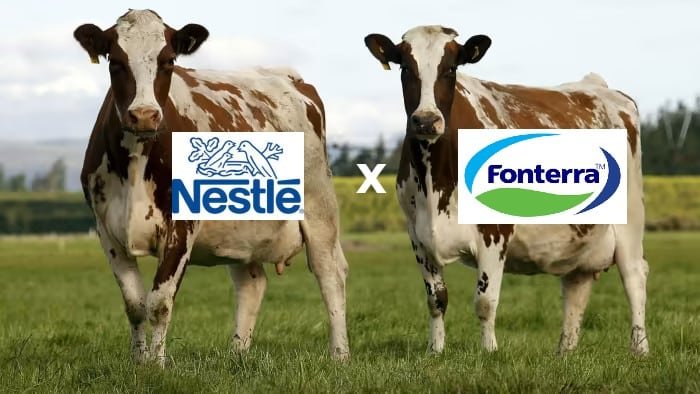Nestle and New Zealand’s largest milk processor, Fonterra have partnered to develop the country’s first net zero carbon emissions dairy farm.
The net zero milk project will assess the dairy farm’s total carbon emissions and will run for 5 years with co-partner Dairy Trust Taranaki.
It aims to reduce emissions by 30% by mid-2027 and achieve net zero emissions in 10 years.
The pilot project will be on a 290-hectare property, and any insights and activities will be shared with other farmers to increase adoption. Farmers can then adopt techniques and technologies most suitable for their own farms.
Reducing New Zealand’s Dairy Emissions
The agricultural industry makes up 48% of New Zealand’s overall emissions. Methane, nitrous oxide (N2O), and CO2 are the key components of the livestock industry’s total emissions.
- The Institute for Agriculture and Trade Policy (IATP) says 15 of the largest dairy companies in the world (including Fonterra) are responsible for 3.4% of global methane emissions and 11% of total global livestock emissions.
Last month, New Zealand sought to levy farmers for the emissions of their cows. But apart from the cows’ own emissions, the dairy ingredients they provide also emit pollution.
The country has the lowest carbon footprint for milk in the world. Still, dairy contributes about 50% of the country’s agricultural livestock emissions. And about a quarter comes from dairy biological emissions (N2O and methane).
Commenting on the partnership, Fonterra chief executive Miles Hurrell said in a statement:
“New Zealand already provides some of the most sustainable nutrition in the world through its pasture-based dairy system. This new partnership will look at ways to further reduce emissions, increasing the country’s low-emissions advantage over the rest of the world…”
Fonterra is one of the largest dairy producers in the world, and this net zero milk project will help lower emissions with its pasture-based farming systems, ideal climate, and efficient producers.
The announcement comes after Fonterra told dairy farmers earlier this month that it’s planning to set a target for Scope 3 emissions. This source includes farm emissions which are critical in meeting sustainability expectations from customers and export markets.
This New Zealand pilot scheme will hopefully be the first of many global projects. The dairy farm project will help both Nestle and Fonterra in achieving their climate goals. Both aim to achieve net zero emissions by 2050.
On their Way to Net Zero
Nestle New Zealand CEO Jennifer Chappell said that the project would build on the food giant’s work worldwide to help transform the dairy industry.
Nestle has over 100 pilot projects globally, with 20 farms working out their net zero targets. She also added that:
“Dairy is our single biggest ingredient, and our vision is that the future for dairy can be net zero… To reduce our Scope 3 emissions, it’s critical we work with dairy farmers and their communities. Working towards a net zero farm means looking at all aspects of the farm, from cow nutrition to sequestering carbon.”
She hopes that this top-down approach of reaching their broader climate goals will only work by closely looking at the details of dairy farming.
Every farm is different so there’s a need to look for specific levers that might work within each farm to keep monitoring and adapting for the conditions on that farm. They will share any lessons learned along the line to mainstream on-farm practices that can slash emissions from dairy production.
Dairy and livestock farming account for around 33% of Nestle total emissions. So to meet their climate goals, the company must support dairy farming to change its means of production.
- The dairy farm project with Fonterra will help Nestle meet its goals to reduce emissions by 20% by 2025, 50% by 2030, and net zero by 2050.
Aiming to decarbonize by the same period, Fonterra echoes the food company’s outlook. Miles Hurrell noted that their partnership will enable their customers to also reduce their footprint.
The CEO further said that working with Nestlé will help their farmer-owners discover solutions to the industry challenges.
“Working with partners like Nestlé is our best opportunity to create innovative solutions to local and global industry challenges.”
Cutting On-farm Dairy Emissions
The partnership also involves launching a support program for dairy farmers. Farms enrolled in the project will get additional support from Fonterra to allow reductions in on-farm emissions.
Solutions may include improved management of feed and pasture and enhanced milk production efficiency. The pilot will begin with about 50 farms and be scaled up over the next 3 years.
In the U.S., Neutral Foods is a company that tracks and buys carbon credits to neutralize emissions from dairy farms. It’s also partnering with farmers to help them cut their own emissions at the source.
Neutral Foods measures the emissions of its dairy products’ entire lifecycle. Then the company buys carbon credits for the emissions it wanted to offset.

